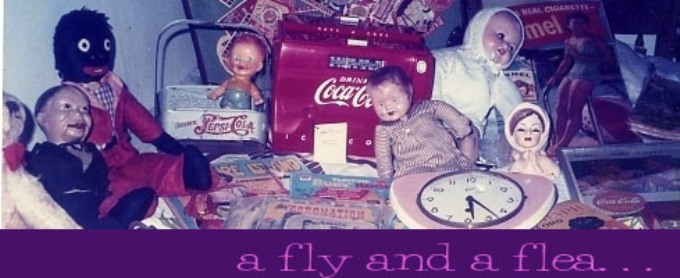 One of my most fascinating finds during my Bangkok years was this plaster cast mannikin figure of a Thai woman for some defunct department store in Thailand. This must have stood on a countertop, perhaps promoting the fashions of the day. I have seen similar countertop mannequin displays of U.S. make, but this one definitely is a local creation, with distinct Malay features that could very well pass for a Filipina beauty.
One of my most fascinating finds during my Bangkok years was this plaster cast mannikin figure of a Thai woman for some defunct department store in Thailand. This must have stood on a countertop, perhaps promoting the fashions of the day. I have seen similar countertop mannequin displays of U.S. make, but this one definitely is a local creation, with distinct Malay features that could very well pass for a Filipina beauty. The figure stands 24 inches tall and stands on a base with a Thai script that I can't decipher. A Thai friend said it reads "THAI PHAIRAT", but is not sure if that's the name of a shop. There are holes on her heels that you can slip through metal pegs attached firmly to the base. The only individual parts are the arms, which were connected by inserting the metal strips at the shoulder of the figure. One metal strip has been lost, so when I got this, the lady figure was armless. Some fingers have also been chipped off her hands and there were broken or cracked parts of her arms and body that have been glued back securely.
The figure stands 24 inches tall and stands on a base with a Thai script that I can't decipher. A Thai friend said it reads "THAI PHAIRAT", but is not sure if that's the name of a shop. There are holes on her heels that you can slip through metal pegs attached firmly to the base. The only individual parts are the arms, which were connected by inserting the metal strips at the shoulder of the figure. One metal strip has been lost, so when I got this, the lady figure was armless. Some fingers have also been chipped off her hands and there were broken or cracked parts of her arms and body that have been glued back securely.Despite these imperfections, I found the Thai "puying" (lady) really pretty--her hair was styled in a neat bun, and her morena complexion only gave her lots of Pinay appeal. For years, I kept her, as is, with a wrap-around skirt and draped in lace on one shoulder, simulating a Thai costume. She used to wear a strand of pearls, which I have since misplaced.
 One day, an idea just occurred to me to dress her up--not in chic clothes that she probably once wore--but in a Filipiniana costume. I visualized her in a checkered patadyong, with a kimona top, with a wrap-around tapiz and a panuelo.
One day, an idea just occurred to me to dress her up--not in chic clothes that she probably once wore--but in a Filipiniana costume. I visualized her in a checkered patadyong, with a kimona top, with a wrap-around tapiz and a panuelo. I took my Thai mannikin to a restorer of religious figures who willingly took on my unusual project. He fashioned the kimona top using a scrap of embroidered fabric from an old Filipiniana dress. A suitable checkered cloth became her skirt and the panyo. A few weeks after, my Thai miss mutated into a Pinay dalagang bukid! Here are the amazing results of that transformation.
I took my Thai mannikin to a restorer of religious figures who willingly took on my unusual project. He fashioned the kimona top using a scrap of embroidered fabric from an old Filipiniana dress. A suitable checkered cloth became her skirt and the panyo. A few weeks after, my Thai miss mutated into a Pinay dalagang bukid! Here are the amazing results of that transformation.



















